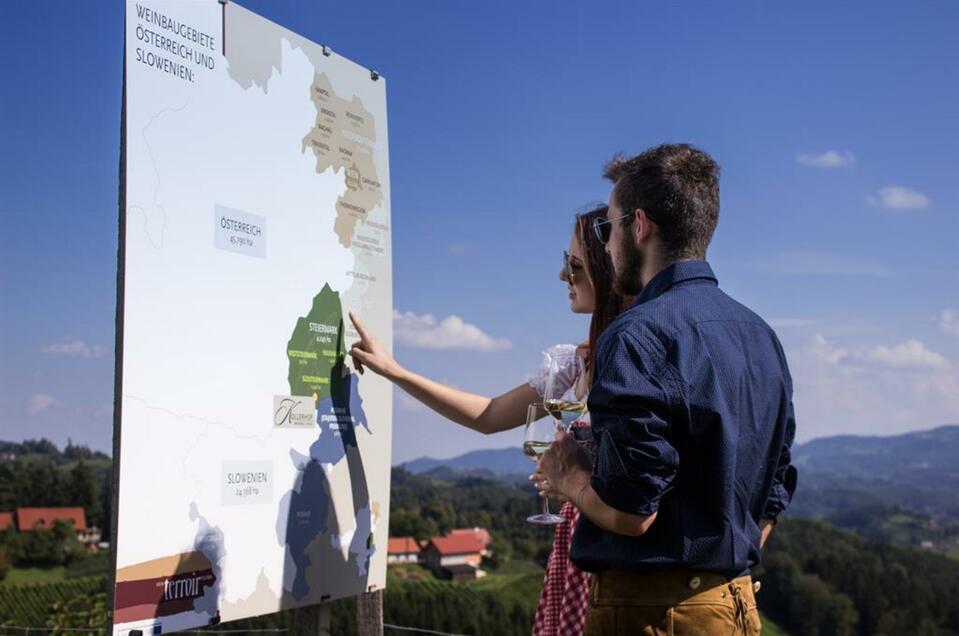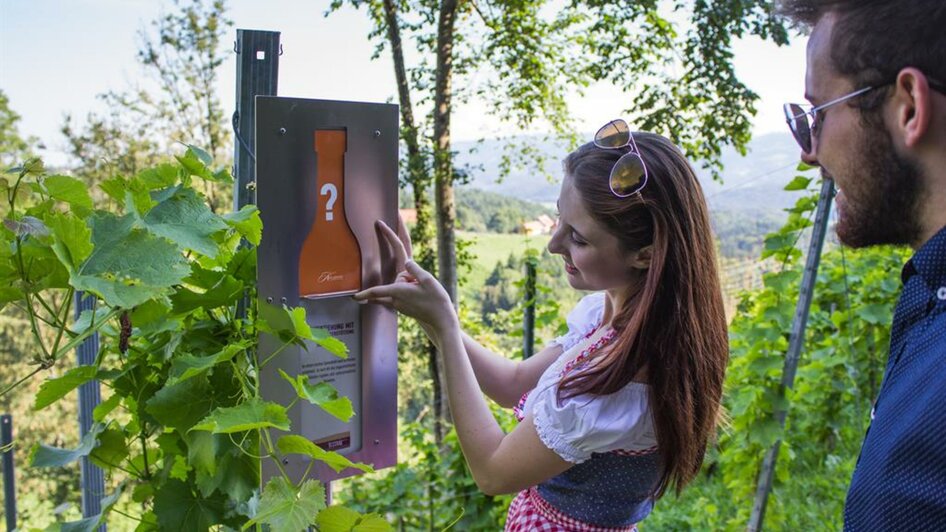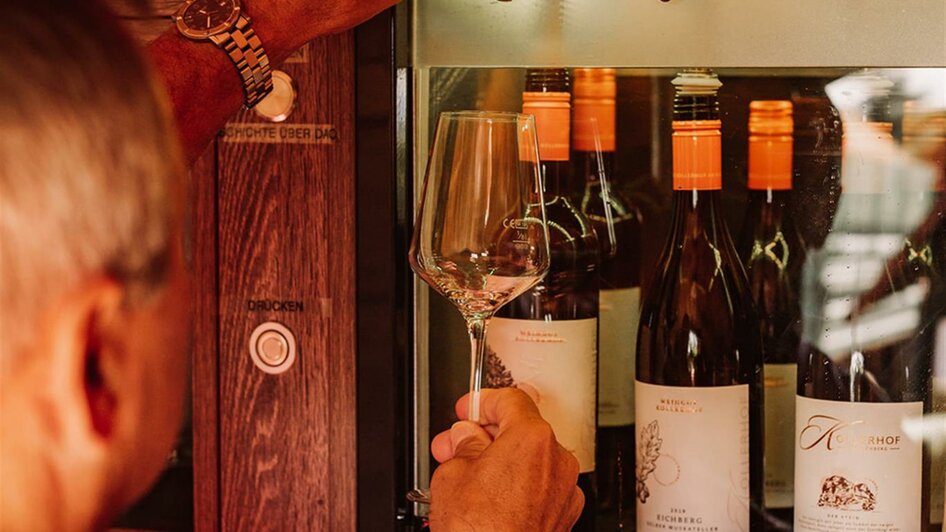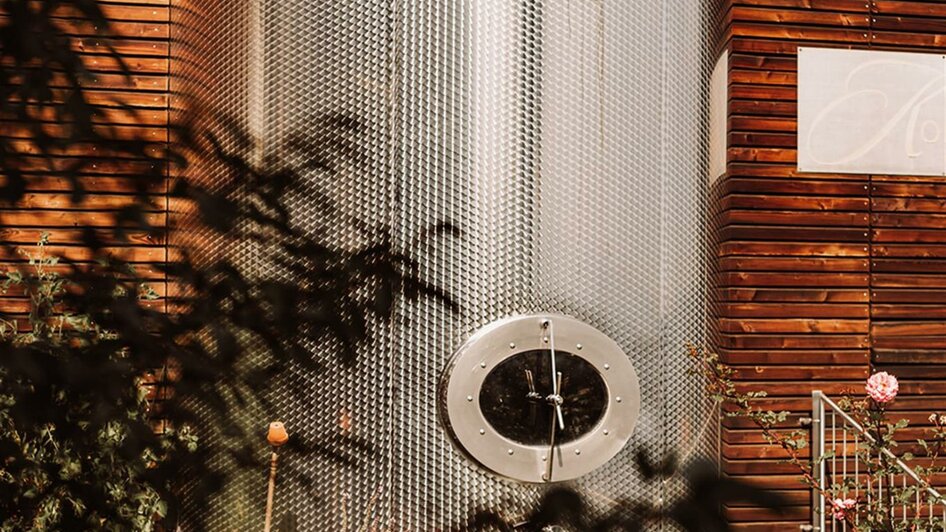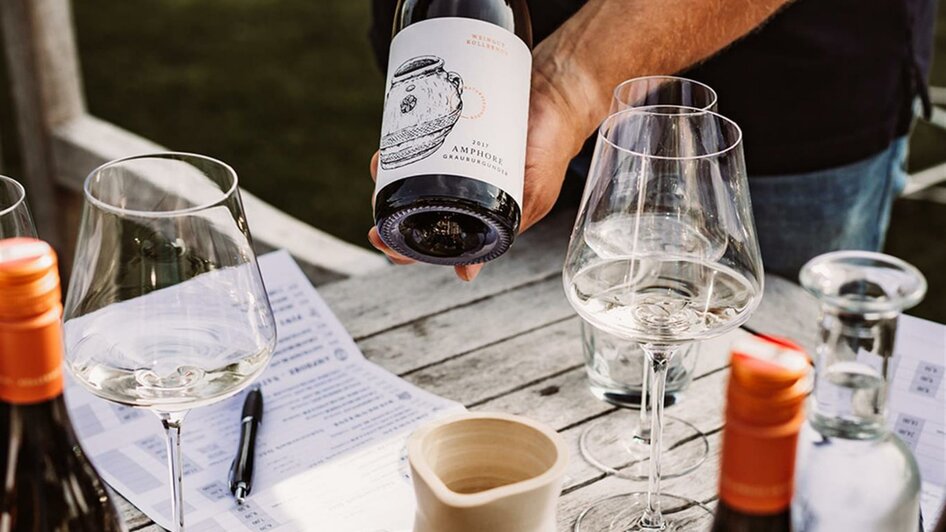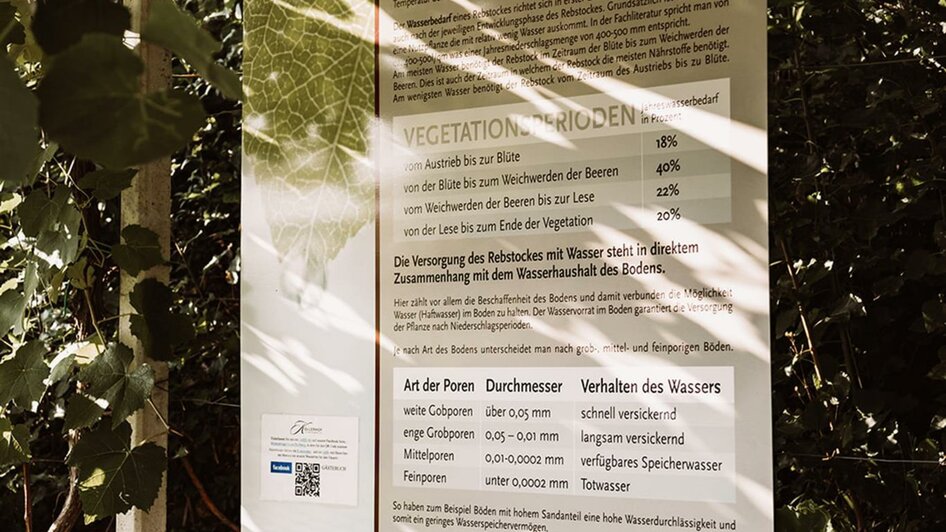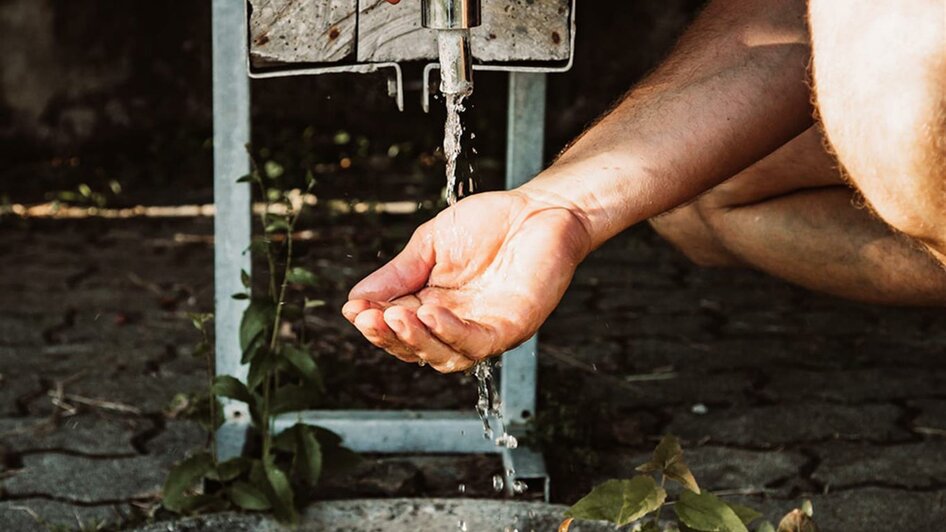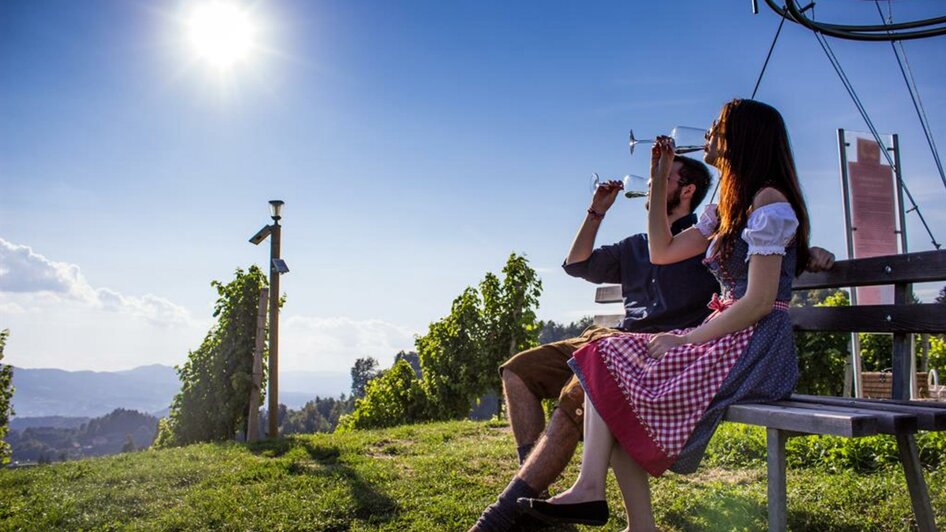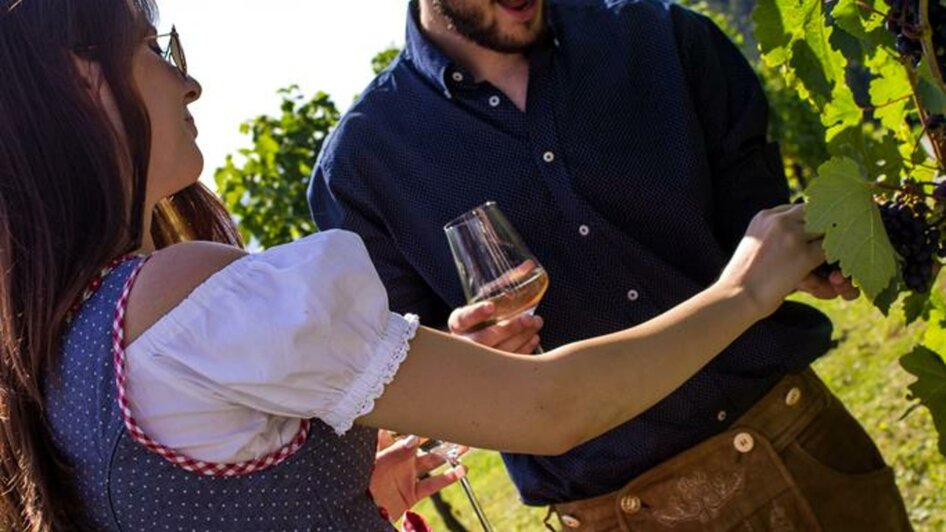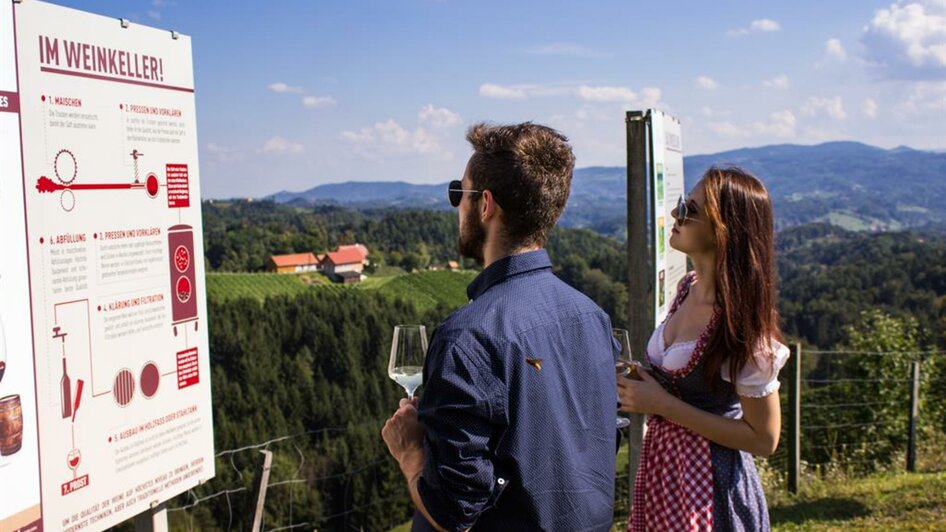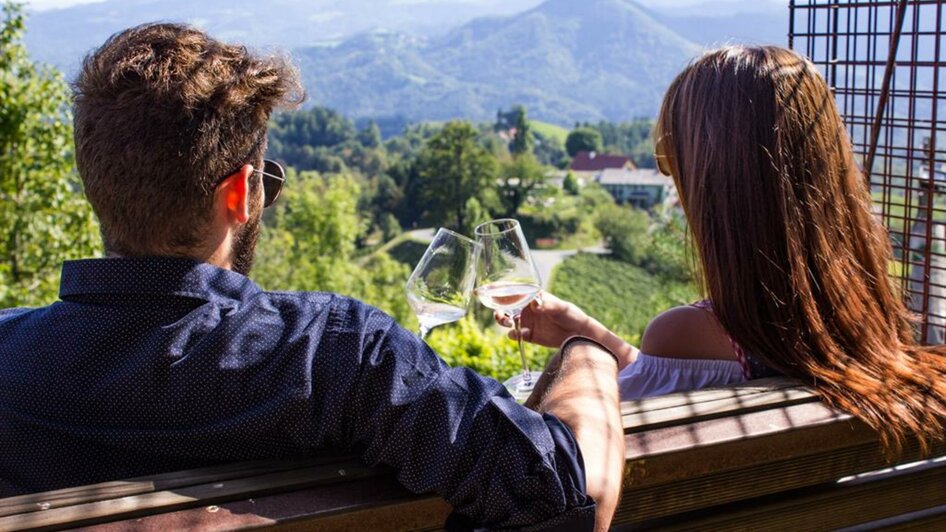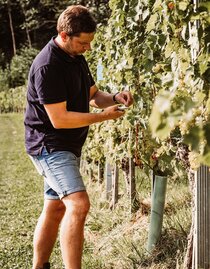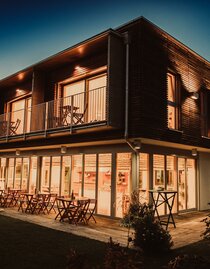Weinerlebnistour, Weinkulturgarten, moderner Klapotetz
Leutschach an der WeinstraßeWine experience tour: "From the grape to the wine"
From April - October on request
-Guided tour through the wine culture garden
-Historical information about the wine museum
-Tour of the DAC wine barrel
-Winery tour with cellar tour
-Tasting with 6 wine samples incl. bread & water, as well as 2 schnapps samples
Please allow 2.5 hours. Price per person € 14,00.
Afterwards you are welcome to reserve a table at the Buschenschank.
Table reservations are requested.
The tour takes place in all weathers. Contact: +43 3454 439
Wine culture garden and modern Klapotetz (accessible all year round): Wine museum: April - end of October Tasting and guided tour: by telephone Registration is requested.
Along the wine culture garden, you can learn interesting facts about wine history and viticulture from the display boards. Various grape varieties, planted along the path to the modern Klapotetz, invite you to taste them... or follow the GPS-guided tour with lots of information, via terroir locations with picture-book views for a cozy stay, to the tasting and the exciting conversation with the "winemakers"...
Wine culture means much more than just drinking good wine. To learn the truth about this millennia-old drink, the wine culture trail offers theory, practice and lively illustrative material. Immerse yourself in Styrian wine culture on two kilometers suitable for baby carriages. If you have also correctly solved all the quiz questions on the last page at the individual stations, we invite you to enjoy a glass of fine wine at Kollerhof Lieleg!
Wine culture trail
Introduction Wine culture means much more than just drinking good wine. To find out the truth about this millennia-old drink, the Wine Culture Trail offers theory, practice and lively illustrative material. Immerse yourself in Styrian wine culture on two kilometers suitable for baby carriages. If you have also correctly solved all the quiz questions on the last page about the individual stations, we invite you to enjoy a glass of fine wine at Kollerhof Lieleg! Quote from Harald Lielelg "Wine has been cultivated here for centuries and so I wanted to make this wonderful history a wonderful experience for everyone. I'm already looking forward to your visit after the round, because the questions are not too difficult and otherwise I'll be happy to give you extra tuition over a glass of wine. See you around!"
Station 1: The Styrian wine country:When scenic beauty, fine wine, culinary delights and friendly people come together somewhere in a perfect symbiosis, then it can only be the "Styrian wine country". Here you will find the most important facts and figures!
Station 2: Styrian exotics:Every wine region has its own grape varieties. But we Styrians are also open to other national and international grape varieties, and here you can see a few of them, from Veltliner to Syrah. Tip: Try to compare the different ampelographic characteristics (leaf shape, color, growth, etc.) of the individual grape varieties! Now that you've learned some theory, it's time for the "practical" part, so go on and immerse yourself in Styrian wine up close! This place is also an ideal starting point for many hikes on the Eichberg and around Leutschach.
Station 3: Geology Tip: Here you can actually "experience terroir" and see the special soil characteristics of the Eichberg. Our wines get a lot of their characteristics from the special soil. Every rock, every type of soil can also be tasted and felt in the wine! Tip: If you pass the conglomerate wall along the way, try smelling the stones - this is the much-praised "minerality" of our wines!
Station 4: Insect hotel: The "Berg- und Naturwacht" has set up countless insect hotels in the region. Our "tidy" landscapes offer less and less space for useful insects. Such an artificially created nesting and hibernation aid provides an important habitat for insects and thus strengthens biodiversity. Tip: If you look closely, you can recognize many different dwellings, inhabited or only used in winter.
Station 5: Conglomerate wall: The typical Eichberger conglomerate can be seen on this mighty wall. Conglomerates are either formed from deposits of rivers with high transport capacity or they form on eroded coasts (beach conglomerates) and consist of rounded gravel or boulders. Tip: Take a close look to see if you can recognize the fine root structure of the overlying plants that have to work their way through this hard layer!
Station 6: Beneficial insects/pests: The classification "beneficial or pest" in a cultivated landscape is naturally made from a human perspective. But in order to make a living from viticulture, you have to be able to deal with these creatures. Tip: Enjoy the view of the valley to Leutschach and the Slovenian pilgrimage church "Sv. Duh (Holy Spirit)
Station 7: Vine training: Even a vine needs to be trained properly to produce a good yield as an adult. Depending on the grape variety, soil, climate, etc., there are different ways of guiding the otherwise wild-growing vine in the right direction. Tip: Now try to recognize the vine training used in the following vineyards!
Station 8: Tasting line: On this 300 meter long line you will find an excerpt from the Styrian/Austrian wine assortment, including a few "exotic" wines. In the fall you are welcome to taste INDIVIDUAL grapes. Tip: When tasting, try to find a few of the familiar aromas in the finished wine in the fresh grape!
Station 9: The arbor: Here you can learn a lot about "water and soil", but you can also use the arbor to take a break, have a snack or enjoy the view! Tip: The locations of the forests in comparison to the vineyards clearly show the sunny south-facing locations for the Vienna Gardens!
Station 10: Modern Klapotetz: This new interpretation of the "Klapotetz" is the work of architecture student Ulrich Hagen, who created a somewhat different kind of Klapotetz in its formal and artistic design and was selected from a total of 17 models submitted and made by local craftsmen. Info This new interpretation of the "Klapotetz" is the work of architecture student Ulrich Hagen, who created a somewhat different kind of Klapotetz in its formal and artistic design and was selected from a total of 17 models submitted and made by local craftsmen.Tip: You can now walk back along the leisurely Wine Culture Trail to experience the other stations, or you can choose the somewhat steeper version of the "Terroir Experience" circular trail!
Station 11: Slope stabilization: Vineyards are cultivated landscapes and often have to be wrested from nature with a great deal of effort. Due to the often heavy rainfall, slope stabilization around the vineyards is essential. In 2015, for example, part of this path and a vineyard were destroyed by a landslide. Tip: When looking at the landscape, try to compare natural landscapes with created cultural landscapes!
Station 12: Wildlife protection: Most of the vineyards are surrounded by wildlife fences. Because deer also love the sweet grapes, and a family of wild boar can dig up a vineyard in no time at all. Tip: Note that the distances between the wire in the wildlife fence shorten as you go down!
Station 13: the Clavicula: This classic clavicula was erected as part of the celebrations for "60 years of the South Styrian Wine Route". This scarecrow is said to keep the birds away from the vineyards at grape ripening time with its rhythmic clattering.
Station 14: Piwi: Viticulture is working with and for nature. Fungus-resistant grape varieties - Piwi for short - are intended to reduce the use of pesticides to a minimum and thus also make a contribution to combating climate change. And the new grape varieties should also taste good and expand our Styrian aroma spectrum. Tip: Your opinion is important to us! At the Kollerhof, you can already taste a few trials of Piwi grape juice.
Station 15: Old press house: You can now experience the work involved in wine production in earlier times directly at the Kollerhof. The grape musts were pressed in the old press house, which were then fermented and matured in the old stone cellar opposite. Tip: If you want to know what a Buschenschank actually is, use the display board at the press house!
Station 16: Wine museum: Many old, still functioning craft tools are on display here. Just a few meters away, you will also find the modern cellar at the Kollerhof. We would like to invite you to take a look inside. Tip: Try to retrace the production process from the press to the barrel using the old tools!
Station 17: Buschenschank: Thank you very much for immersing yourself in the world of South Styrian wine! As a small thank you, and also to help you answer the questions, we would now like to invite you to taste some of our wines. The Buschenschank is also available during our opening hours with a delicious snack. Tip: You are also welcome to taste our own lamb and fish specialties! You are also welcome to use our e-filling station free of charge.
April to October on request
Contact
Birgit & Harald Lieleg
Eichberg-Trautenburg 39
8463 Leutschach an der Weinstraße
